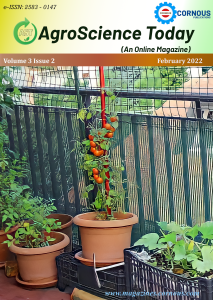Electronic textiles (e-textiles) are textile products that have electronics and interconnections embedded into them. Components and connections are a part of the fabric and thus are much less visible and, flexible with the material and comfort to the wearer. ICAR-Central Institute for Research on Cotton Technology CIRCOT, Mumbai is a pioneer organization working on the post-harvest processing and value addition of cotton along with the application of recent technological advancement for fibre manufacturing. The institute is engaged in conducting research and development to manufacture many smart textile products.
Terrace gardening is a practice of having a garden in any open space at top of the building. It has good aesthetic purpose and may provide fresh self-cultivated produce; it reduces the house temperature and can also be a habitable place for some wilds. In India most houses have flat roof tops. Well those can be transformed into beautiful recreational terrace gardens. Increasing population trends in India stressing each and every farming product into greater demand and making its quality very low. Hence the better way to recover our lost nature and to conserve the remaining ecology terrace gardening is the prime alternative.
Morchella is a savory diet fungus. It is also known by the name Morel and is the world’s most prized edible fungus. About 400 Morchella species have been reported from various parts including Asia, USA and Europe. True morel (Morchella spp.) which includes edible Morchella has health values because of presence of phytochemicals in its tissues besides phenolic compounds and vitamin D. It is the flavor of this mushroom which makes it savory and medicinal value as a perfect diet.
Cultivating enough food to feed the world’s population comes with high environmental tag. “Agriculture is the backbone of India”. Food is the primary source of energy for every living organism in the world. Due to the increase in the population growth of world, the requirement of energy source and food need is rapidly increasing. This population rise leads to increase in industrialization and in need of comfortable living space. So, that the land area requirement is quite reducing for cultivation of agriculture produce. To meet the supply and demand, there is in need to increase the intensity of crop production with no compensation in quality and quantity of the produce. This paves a way for the soilless culture to meet the demand of food scarcity.
Rapid generation of homozygous lines in genetical studies and crop improvement programmes are aimed for the stability to study the expression of traits and selection of superior lines in segregating populations for the development new crop variety. Functional genomics studies involving T DNA tagging, insertional mutations, CRISPR-Cas 9 mediated genome editing is being utilized for identifying the mechanism of gene actions. Homozygous lines will be having stable expressions and opted materials for transcriptomic, metabolomics and structural genomic studies. Rapid development of mapping populations viz., recombinant inbred lines, near isogenic lines and homozygous lines are necessary for structural genomic studies. Homozygous lines respond well to nutrient uptake studies, plant pathogenic interaction studies, and abiotic stress tolerances. In vivo methods like MATL and CenH3 mediated haploid inductions are genotypic independent and easy system to generated larger number of stable DH lines for crop improvement and genetical studies.
The plant parasitic nematodes are the hidden enemies of many crops causing huge losses by infecting individually or causing complex disease by interacting with other plant pathogens. The horticultural crops are the cash crop of growers and because of their high nutrient value, the production cost is also high. For getting off-season products, protected cultivation is getting beneficial for handsome earning of cultivators but due to plant parasitic nematodes, the quality and quantity of these produce are hampered and proper return could not be achieved in market. Since these organisms are microscopic and most of them are found in soil so, they could not get noticed. Their population could not be irradicated because of their high population and very well developed survival strategy. So, managing them below economic damaging level, certainly helps in enhancing the quality of produce and good return to the farmers.
Breeding of rice for low water requirement is a long term goal and it can be achieved with development and cultivation of aerobic rice genotypes. Component traits of aerobic rice needed to be genetically and phenotypically characterized for the successful incorporation. Traits viz., seedling vigour, salinity tolerance, water use efficiency, root exudation, microbiome association, nutrients mobilization and utilization, nutrients use efficiency, higher temperature tolerance, spikelet fertility. These traits should be phenotypically characterized and genomic regions regulating the traits should be identified for successful incorporation to evolve an aerobic rice genotype suitable under tropical upland rice ecosystem with increased productivity levels and less water requirement abilities. Screening methods should be standardized with controlled water application methods, and temperature regulations during critical stages of growth. Magical populations should be evolved by crossing multiple divergent parents to bring the wider genetic pool in one genetic background for the introgression of component traits of aerobic rice genotypes.
